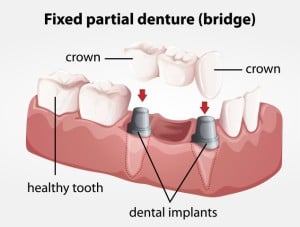 There is no such thing as a tooth that you can afford to lose. Every one of your teeth is vital to chewing, speaking and maintaining the alignment of neighboring teeth.
There is no such thing as a tooth that you can afford to lose. Every one of your teeth is vital to chewing, speaking and maintaining the alignment of neighboring teeth.
Losing teeth is not an inevitable part of aging, but if and when you do lose teeth, it’s important to remedy the problem immediately with a dental implant or dental bridges.

What Is A Dental Bridge?
Dental bridges, also known as fixed partial dentures, are devices which can replace lost teeth. They attach new artificial replacement teeth to adjoining natural teeth (abutment teeth). Both removable and fixed (permanent) bridges are available. Removable bridges are attached to the adjoining teeth using clasps or other attachments, while permanent bridges are either bonded directly to the abutment teeth or with crowns placed on the adjoining teeth. Fixed bridges are more common due to their greater stability, but some patients prefer removable bridges since they can easily be removed for cleaning.
Missing teeth can make life more difficult than you might think. From your appearance to speaking and eating, losing one or more teeth can cause problems. Fortunately, any missing teeth can be replaced with fixed or temporary dental bridges in our office.
Why Might I Need A Bridge Or Dental Implant?
Other than making it easier to chew and speak comfortably, appearance is an important consideration. Your teeth help support your cheeks and lips. Losing teeth, especially in the back of your mouth, can cause your mouth to have a sunken appearance. A bridge provides this support and restores the natural contours to your face and mouth.
There are also some health factors to consider. Losing teeth can significantly increase your risk of gingivitis and other gum disease; replacing lost teeth with dental bridges can minimize this increased risk. Missing teeth can also lead to speech impediments, since our teeth are integral to our ability to pronounce certain sounds.
Finally, teeth adjacent and opposing the missing tooth or teeth will eventually move into the space. This can drastically change your bite and will most often require braces to correct.
How Are Dental Bridges Attached?
Having a dental implant or bridge attached generally takes two or three appointments. At your first appointment, Dr. Frey will first prepare your teeth for the bridge by removing some enamel and dentin from the teeth on either side of the gap. We’ll also take impressions of your teeth, which will be sent to our lab so that a bridge can be constructed which fits your mouth perfectly.
Once the new bridge is finished, you’ll come in for the attachment procedure. A fixed bridge will be bonded to the abutment teeth using dental cement, with a false tooth replacing the missing natural tooth. The bridge is supported by dental crowns cemented to the adjoining natural teeth.
What Kind of Materials Are Dental Bridges Made From?
Our lab can construct bridges and implants from gold alloys, porcelain, or a combination of materials. If your bridge includes metals, then porcelain will often be bonded to it for added stability. We only use precious metals to avoid any possible metal allergies.
Care And Maintenance For Dental Bridges
Taking care of your new bridge is exactly the same as taking care of your other teeth. A daily dental hygiene routine of brushing and flossing will keep both your bridge, the neighboring teeth which support it and your beautiful new smile clean and in good health.
Dr Frey and his staff are very friendly and professional. They spent a lot of time going over my treatment plan and let me decide what I wanted done. After my appointment Dr Frey called in the evening to see how I was doing. They made my experience pleasant. I would recommend him to all of my friends and family.Thank you Dr. Frey for giving me a new smile!






